MAIN MENU
Diamond Doves
Site Map
Diamond doves
Acquiring Diamond Doves
Caring for Diamonds
Living With Diamonds
Raising Diamonds
Growth of a Diamond Baby
One Year's Reproduction Data
Tribute to China
Other Dove Species
Other Geopelia SpeciesRingneck Doves
Eurasian Collared Doves
Cape Doves
Mourning Doves
Mourning Dove Baby Growth
Rock doves
North American Doves
Dove Genera of the World
All Doves
Caring for Injured or Sick DovesTaming Doves
Other
Books of Interest
Some Bird stories
About Me
Links
Informational Sites
American Dove AssociationCommercial Sites
Jeff Dowining - Diamond DovesGarrie Landry - Diamond Doves
Wade Oliver - The Dove Page
Doveland Press - Diamond Doves
Raising Diamond Doves
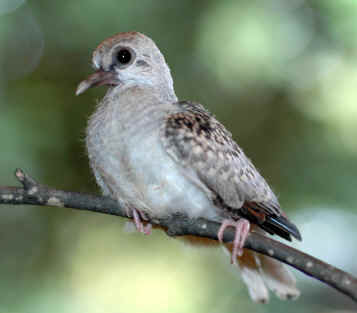
November, Age 12 days, Hatched 11/10/2007
Page Contents
Once the baby has hatched it will begin to soil the nest with its
stools. Most diamonds will then want additional nesting material to cover
the old, dirty material.
Often new birds will sit
on their eggs for a few days and then abandon their nest. If that is happen you can
place the eggs in the nest of some older birds if you have any or you can try to
incubate the eggs and raise the babies yourself. See below.
I have found that the parents that have abandoned their eggs will
soon mate and lay another set. After one or two starts they will usually settle down
and stay on their eggs throughout the incubation period - as long a food and water are
available and they are not badly frightened or otherwise disturbed.
The first of the two eggs will hatch in about 14 days (13
to 15 days) and the second egg will hatch between 11 and 12 days. You will know when they have
hatched because you will find broken egg shells hidden somewhere in the cage. It is then
very important to see that the birds are not frightened as if they move around suddenly in
the nest they may step on a baby and kill or maim them. Never pick up a parent bird at this
stage to see the babies. After a week, the babies are much larger and much of the physical
danger to them has passed. They will fly before two weeks and then the parents try to persuade
the babies to feed on their own. Once the babies can peck their own seeds, they probably should
be removed from the parents' cage. However, I have occasionally been able to leave babies
in the parents' cage and I have even seen a baby bird sitting on the eggs with their mother.
Recently we have had several babies stay in the cage with their parents until
the next clutch hatched. You need to watch this situation carefully, though, as the parents
may all of a sudden decide they have been around too long and attack them.
People often ask me what they need to do when their diamonds are
about to hatch out their babies. I would suggest that they obtain some baby
bird formula in case supplementary feeding is needed. See the paragraph
titled Emergency Baby Feeding near the end of this page for instruction on
feeding and formulas. I usually recommend not disturbing the babies for
the first week. But keep an eye out on the cage floor as if babies are two
weak to feed they will sometimes throw the baby out of the nest. If you
find a baby on the cage floor that is cold but still alive, he immediately needs
to be warmed up. You can hold the baby in your hands under a light bulb
that generates hear until his body is thoroughly warmed. Of you can very
carefully immerse the baby in warm water and hold him there keeping his head out
of the water until his body is thoroughly warmed. Then you can blot off
the water with a soft paper towel since he will not have any feathers and
then hold him under a lamp until he is absolutely dry. Then see the emergency
feeding of babies section below. Once he is fed and his crop is full you
should be able to return him to his nest and the parents will usually take over.
You should try to look at both babies from
time to time time see if their crops are full. See the photo below to see
what a full crop look like. Often the baby that hatches out second does
not get enough food and may die without supplemental feeding. Experienced
parents avoid incubating the first egg until the second egg hatches so it will
hatch at about the same time as the second egg. Then the babies will be
nearly the same size and able to compete for their parents food on an equal
basis. A consistently empty crop after day 2 - 3 requires removing the
baby and providing supplemental feeding, When you remove a baby from the nest
for supplemental feeding it may be best to deftly lift
the parent completely off the nest so they do not try to fight you and possibly
injure the babies in the process.
A very small baby with it eyes still closed - notice the
full crop
People often write in and ask why their new doves have not
mated, made a nest, and laid eggs. Doves that have been recently moved
from one location to another are under a considerable amount of stress.
Before they think about bonding, mating, nest building, etc. they need to
recover from the stress and feel that they are now living in a stable
environment. This could easily take one or two weeks or more. If
the birds were not bonded prior to the move, it also may take some time before
bonding will happen. In most cases bonding will probably take place in
lest than a month, but I had one pair that was living in a cage together
take six months before they mated and eggs were laid. I also had a
handsome male wait two years before he finally selected a suitable female out of
those that were available.
The best solution to many of these problems is simply to have the patience to
allow the doves making a family on their own time.
Below is a summary of the most common problems. Fertilized eggs do not hatch because of a number of reasons: Sometimes homes have low humidity levels and if steps are taken to increase
the humidity around the nest then often the eggs will hatch. Poor lighting may
have an effect on incubation. Some species place their nest in a location
where it will receive a certain amount of sunlight during the day. Other than
the above the only other thing I know of that can be done is to be sure the
birds have quiet, stress free environment for egg incubation (see below). I really do not know why doves often choose to not lay their eggs in the
nest. I can guess at some of the reasons but I have not done any
experimentation to prove or disprove this reasons Doves will often lay their eggs inside a seed cup rather than in the provided
nest box. Why they do this is a mystery to me. To correct the process we have found the following procedures usually work -
perhaps only after several tries. As I remember these procedures worked sooner or later with all out dove that
started off laying eggs outside the nest. There are a number of reasons why a diamond pair will not incubate their eggs
continually from the time an eggs is laid until the babies hatch out.
First it is normal for the eggs to be incubated
from the time the second egg is laid until the babies hatch out. Young
pairs may incubate their eggs from the time the first egg is laid but I have
found that after a few clutches the incubation will be started once the second
eggs is laid. This is to insure that the two chicks will hatch out at
nearly the same time and will this be of nearly the same size. Otherwise
the bigger chick will always get more of the food and the smaller chick may
starve to death. If the second chick's crop is rarely fully inflated
then supplemental feeding is recommended to help him survive. Normally females will incubate the eggs during the night and most of the day. Males will
switch off with the female at various times during the day so she can eat and
rest. Both males and females will incubate the eggs at the same time
(double nesting) during the last few days so that higher humidity and
temperature levels are maintained. Below is a list of reasons why the eggs may
not be continually incubated from the time the second egg is laid.
Eggs are not fertilized because the male is infertile or
because of improper mating which often happens with a young pair. Once
they have attempted mating two or three times they usually are successful.
Eggs also are not fertilized because the sperm does not pass to the female
because of thick feathers around the cloaca in one or both of the partners
In this case the feathers can be carefully trimmed with a small pair of scissors
or nail clippers
There are other reasons for eggs that are not fertilized. The chart
below summarizes the possibilities. Correction of any of last six cases requires the identification and
replacement of the bird that is infertile. There are other possibilities including fertility changes with age.
Females can only produce a finite number of eggs. When the supply is
exhausted they will not have any more eggs. It should be noted that females can be stimulated by a close relation with a
human and they will produce two infertile eggs. Birds can not distinguish between fertile and infertile eggs, so they
incubate infertile eggs for the same time they will incubate fertile eggs.
My feeling it is best to let them remain on the eggs for the full 14 days
because then the female will not lay new eggs but once every three weeks or
so. If the eggs are removed from the nest, the female could have new eggs
every three or four days. This high level of egg production could be
damaging to her health by lowering calcium levels in her body. I would not remove the eggs in these situation
until the birds abandons the eggs and this may be several days past the normal 14
day incubation period. Diamond doves normally lay the first egg of the next clutch when the
current baby is about 13 days old. Since it take about two days for an egg
to be formed, this means the male will often start courting the female when the
baby about 10 or 11 days old. Sometimes the female may prefer to delay the
production of the second egg feeling that the current baby/babies need the
parents full attention. Charlotte Van Hoozier's data indicated the first
egg of the new clutch may be laid anywhere between an age of 10 to 16 days age
of the current clutch but the average age was 13.2 days. If the female prefers to delay the first egg of the next clutch she may have
a disagreement with her mate that could result in fighting. If you can not
convince the male that his mate may have a valid reason for delaying the first
egg of the next clutch, then I would suggest the male be removed form the cage
and placed in a spare cage and getting the female to take care of the babies. Then from time to time put the
male back in the main cage and place the female in the spare cage. Thus
the female gets a chance to rest, eat, and drink and the male can use his food
to feed the babies. Do watch the babies crops to be sure they are being
fed enough. If not you might want to consider supplemental feeding.
After a day or two you can return the male to the main cage to see if the two
will have a meeting of the minds regarding this issue. First it should be noted that a baby sometimes appears on the floor of the
cage, not because the parents threw the baby out of the nest, but rather because
the baby accidentally fell out of the nest. This could be because the
parents accidentally pushed the baby out, the fact that the wall of the nest box
was too low, or because too much nest material was placed in the nest box.
Sometime the parents get carried away when they really like the available nest
material. In any case the baby should be warmed (if cold) (see below) and
returned to the parents. Of course a new nest box may be needed or some
nesting material may need to be removed from the nest box.
Old time breeders often say that the parents remove baby birds from their
nest when they believe the babies are somehow defective, perhaps in ways that we
can not perceive and will never grow up to be productive adults. Thus the
old recommendation is to accept the parents' verdict and not waste time trying
to rehabilitate these chicks.
Over the years we have experienced a number of
these situations and have found the most babies are thrown out of the nest
because they are too weak to hold their heads up to feed. We do not have
any information why this is the case. In more than 20 years of raising diamonds we only had two
cases where chicks were tossed out for other reasons. One bird was an
albino and in the end had poor vision and could not fly and another was a dark
colored silky bird that also could not fly. No matter what the reason the birds
was thrown out for, if we found it before it became cold and died, we were able
to warm and hand feed the bird and then either return it to its parents or if
rejected again then hand feed it until it was able to peck seeds. See the
"Emergency Baby Care" and "Emergency Baby Feeding" sections
below for instructions for caring for such a baby.
If the baby that was tossed
out has become very cold before you found it, do not give up without trying to
warm it. The fastest way to warm such a baby is to immerse it in a bowl of
warm water having a temperature of about 110 degrees F - slightly higher
than the bird's body temperature. Hold the baby in your hand keeping its
head out of the water and wait until you see considerable movement.
Recognize you want to warm the entire body not just the skin. After you
are sure it is sufficiently warm, then remove the bird from the water and
quickly dry it with a soft paper towel. (If your are rescuing a older bird
with feathers, the drying process will take much longer and may be facilitated
by using a hair dryer).
Both the albino and the black feathered baby survived
hand feeding and each lived for more than a year. One was killed by
sleeping in someone's bed and the other died after going on a 1600 mile
automobile trip - causes not related to their "birth" defects.
Some people have sent in messages asking about what they can
do if the parents abandon what appears to be a perfectly good set of eggs. If
the parents do not return to their nest within a day or two, I have taken the eggs
and put them in the nest of another pair, and often they will sit on the eggs, and if they hatch,
the foster parents may raise the babies. If they refuse then we have taken over the feeding
process and have successfully raised a number of babies ourselves - we have also lost a few.
If you do not have any foster parents, you might attempt incubating the eggs.
I have never had reason to do this my self so the following is not based on personal experience.
Danny Brown (1) in his book "A Guide To Pigeons, Doves, and Quail"
recommends a temperature of 100 degrees F (37 degrees C) and humidity levels between 55 and 60
percent. A thermometer and hygrometer are necessary for the accurate
measuring of temperature and humidity. If you have a poultry incubator it
can probably be set to these settings. Otherwise the eggs need to be
placed in a box with a lamp that can be raised or lowered for temperature
control and one or more bowls of water for humidity control. The
eggs need to be placed in an egg carton or something similar and stood up so the
narrow tip is pointing up and the axis of the eggs is leaning against the
side of the egg carton at about 45 degrees. The eggs should be rotated 180
degrees left to right in the morning and 180 degrees right at night.
Incubators may turn eggs up to 25 times a day but it is felt that turning them
twice a day may be adequate. Danny Brown (1) maintains that egg turning is
essential for the normal growth and development of the embryo.
It should be noted that eggs that are abandoned after laying, can be kept about
five days before the probability of hatching starts to decrease. Adequate
hatching can be obtained with eggs that are up to ten days old. In both
cases eggs should be kept in a cool dry place, stored pointed end up and turned
twice a day, once to the left and once to the right. Eggs may be kept longer it
stored at a temperature of 55 degrees F and are wrapped in plastic to minimize
the loss of moisture from the egg.
When the babies hatch out they will be very tiny, blind,
and without feathers and should be kept warm at a temperature of 95 to 96 degrees
F (35 to 36 C) (1). As the birds feather out, the temperature can
gradually be reduced to the high 80's.
You should place the babies in a nest box complete with adequate nesting material (See
the "Caring for Diamond Doves" page). Do not place small babies
on smooth surfaces and if you remove a baby from its nest, be sure the baby's
legs are kept underneath their body and not allowed to splay outward. The nest box should be placed in a large cardboard
carton to prevent drafts. A desk lamp with an adjustable neck should be
placed in the carton to provide heat in the nest box, The distance between the lamp and the
nest box should be varied to obtain the proper temperature. The correct
humidity can be obtained by placing a bowl of water in the carton adjacent to
the next box. A thermometer is essential to be sure the temperatures stay
within the the prescribed limits. Be aware that because of temperature
changes in the room during different times of the day, the nest temperature
must be checked frequently and the lamp adjusted as needed. An alternative
heating source could be a small heating pad placed underneath the box, wrapped
in a towel if necessary.
Temperatures for recently hatched diamond doves should be 95 F or 35 C. In
three weeks temperatures can be reduced to 80 F or 26 C. (1)
After hatching babies can be fed using the techniques described in the
section below.
WHEN FEEDING IS REQUIRED: Sometimes parents will
remove babies from their nest during the first two or three days after they
hatch out. Many say such babies are tossed out because the parents know
the babies are defective and will never become healthy adults. My
experience indicates this is not true most of the time. Again and
again I have taken a nearly cold, nearly dead baby from the cage floor, warmed
it, and then fed it with baby bird formula, and the bird survived. In most
cases I was able to return it to the parents nest and the parents gladly took
over the job of feeding the baby. Other times I was able to get a pair of
foster parents to take the baby in when the original parents refused. And
once in a rare while I have had to feed the bird until it was able to peck seeds
on its own.
Other times the parents will not remove
the bird from the nest but will not be able to feed the baby because it is
to weak to stick its head up to receive food from the parents. So it is
worthwhile to watch and see the the parents are able to keep the babies crop
full. In watching the babies I try to get a glimpse of the baby
without physically removing the parent from the nest as the baby might be hurt
if the parent tried to resist my efforts. But if I find the babies crop is
empty or find the baby laying over on one side, then I remove the parent,
take the baby out and feed it until it appears stronger. At that time I
return the baby to the nest and the parent almost always will take over.
FORMULAS: Some of the possibilities for baby bird
formula are listed below. Undoubtedly there are others. The
important consideration is that the squab milk given by the dove parents to
their babies include higher levels of protein (11-23%) and fat( 6-12%) than are
needed by other birds.
The best formula for feeding baby doves is probably Roudybush's Squab
Formula. However it is expensive and hard to find. Some websites
provide for purchase and it probably could be obtained by express mail if
needed.
Kaytee's Exact can be obtained from most pet stores and is
easy to use While this formula was not developed for
doves, it seems to do well for supplemental feeding and we have also used it
successfully for complete feeding from day one until the baby started on seeds
(Kashmir). One advantage of the Exact formula, it allows the use of hot tap
water and thus no cooking is required. Also the birds is easily cleaned using a
little warm water.
Other alternatives include the use of Purina's Mazuri
Parrot Breeder and Pedalyte. The pellets are soaked in hot water and
dissolved in Pedalyte. The mixture is then cooked on the stove to obtain a
smooth blend. After cooling additional Pedalyte is added to obtain the
correct thickness. The same technique is used for the monkey biscuit
alternative or the emergency dog food alternative.
Some of the older books suggest
using Instant Cream of Wheat. We have raised a number of birds on this in
the past but keeping the bird clean can be a problem as the formula does not
easily wash off the birds skin or feathers. Also it lacks the fat content
needed for doves
You can also use some of the
Gerber's baby formulas such as their High Protein Baby Cereal or others that include wheat
without fruit added. In all cases the young baby needs a thin runny formula
which is gradually thickened as the baby grows. The Exact formula starts
off with one part of formula to six parts of water and decreases two two parts
of water at weaning. Kashmir sucking up baby bird formula
FEEDING METHOD: There are many different
methods for feeding baby birds and there
are many opinions as to what is the best method. Others like to use
syringe or fine eyedroppers to place the formula in the babies beak. I
prefer to feed the baby directly from a very small plastic spoon. I
prepare 1/4 of an ounce of formula in a one ounce plastic measuring cup, take
the baby in my left hand and then take a spoonful of formula and dip the tip of
the baby's beak into it. Some seeps into its beak and usually when it
tastes it and feels the warmth, the baby will start to lap it up on its
own. The amount consumed is small and the time it takes is long in the
beginning. If the baby starts to wave its head around as a soon as it
touches the formula it may be too hot. The formula should not feel
either hot or cold when you apply some to the inside of your wrist. If the
feeding process lasts too long then the formula will be too cold and it is best
to prepare a new batch. Recognize that it may take considerable patience
before a new baby will eat much but after the first few hours things should go
much easier. Babies that are three days old may drain the little spoon in
a second and then I simply feed them directly from the measuring cup.
Sometimes you need to be careful that they are not so eager that they thrust
their whole body into the cup.
WATER: Do not
give a baby bird water. It obtains all the liquid it needs from the
formula. (unless you made the formula to thick for the birds age - see the
directions on the formula box), Once the bird is on a seed diet then water can be provided.
FEEDING TIMING: Once a baby has eaten it will usually fall asleep until it becomes
hungry. If you are not returning the bird to the nest, be sure that the baby is
kept in a warm, draft free environment, with a temperature of 96 to 98
degrees. Once the crop starts to appear deflated the baby should be fed
again. Feedings will be frequent the first day - perhaps several time an
hour, but then they will taper off as the baby becomes larger.
AVOIDING "SOUR CROP": This situation occurs when the crop
does not empty and sometimes the baby still wants to eat more. It can be
avoided by not offering more food until the crop is nearly deflated. It
can also happen because the formula is too thick and needs further
dilution. It can also be caused because the environmental temperature is
too
low. Research as shown (1) that the optimum temperature for the
metabolism is between 96 and 98 degrees F. Lower temperatures result in
decreased metabolism and thus a slower movement of food from the crop into the
lower digestive system. In the case of a full crop that does not move, one
remedy is to give the dove warm water and massage the crop. In extreme
cases the crop may need to be emptied using a crop needle. If infection is
suspected then the bird should be kept in a hospital cage environment until the
impacted food leaves the crop
FEEDING
AT NIGHT: Some say you do not need to feed babies at night as parents normally
do not feed at night. But for the first two or three nights we have fed them up to
midnight and then got up two or three times to see if they were awake and if they
were we have fed them again.
ADDING SEED TO THE DIET: After a week or so you
should attempt to add seed (finch seed for wild birds) to the formula and eventually the seed should completely replace the formula.
When the feeding becomes less frequent than three hours, bird seed should be added to the diet. I have always used
finch seed for wild birds. This seed can usually be purchased from
big box stores like Lowe's or Home Depot in five pond bags.. You may be able to mix it with the formula you are using. However
lately I have found once the bird is ready for seed, he or she will often refuse
the formula. Then one must open the bird's beak and drop some seed
inside. To open the beak I use my fingernail or apply gentle pressure with two fingers, one on
each side of the beak. I then pick up seeds with three
fingers of my other hand and pour the seeds into the open beak. The bird's head
can then be released so he can swallow the seed and the process can then be
repeated. I
hold the bird over a small tray so I can collect the spilled seed. You can also try using
a syringe where the tip has
been cut off at a diameter that will allow the seeds to pass through the
opening. Or you can completely cut off the nozzle of the syringe, insert
seed, and then wrap a small piece of cloth around the opening using tape.
Make a hole in the cloth for the birds beak. Others put the seed in the finger of a rubber glove and get the
bird to get the seed by pushing his beak through a hole in the tip of the finger
of the glove. Getting a bird to eat seed for the first time is difficult,
but once you find a way that works for you, repeating the
process becomes easier.
Once the
bird has started to accept seed, and I often place the baby in a seed tray where
older birds are pecking the seed. Eventually the baby will imitate the
older birds, but it may take several days. And at first, although the bird
pecks at seed, the baby does not roll the seed up its beak and into it's
mouth. That will take another day or two.
When you do not have other doves to sue as trainers, another method to get babies that are used to eating seed to peck seeds on
their own is to lay some newspaper on the floor with seed scattered on the
surface. Then with the baby standing on the paper, tap the newspaper
making the seeds bounce up slightly. The bouncing seeds may cause the baby
to try and peck at them after some time.
The babies should be fully feathered within a week and in an average of 11 days they will leave the nest during the day
and sit on the perch to sleep at night. Babies that are still on the floor at the time the lights are turned out should
be returned to the nest.
It is often interesting to watch the family members jockey for position in the evening. The male will be sitting on the perch
and the female will come to sit beside him. Then the babies will try to get in between the male and the female. Then the female may move to
the other side of the male. Then the babies will switch again. And this goes on and on.
Usually it takes a week after they leave the nest before the babies will be pecking seeds on their own.
If we are hand feeding the babies we just stop feeding the them for a day and see what happens. Then if necessary
we will feed them again and repeat the process.
Eventually the parents will feel that the babies need to leave their cage and go live on their own.
By this time the parents probably have already laid the eggs of the next
clutch. The matter is usually
precipitated by large babies continually pestering their parents for food even
though they are fully capable of eating on their own. At an average age of 19 days,
the parents will attack the babies when they begin to beg.
At this point the babies should be removed an placed in a separate cage.
Of course some babies need to leave a few days earlier and others can stay in
the parents cage for a much longer time if they are smart enough not to ask the
parents for food any more. And if they volunteer to help with egg
incubation that may also be a factor in their favor. But in any case the
youngsters should be removed before the new babies hatch. Such babies can
be kept in a "baby" cage for about three months with other
babies. After that they will be sexually mature and will show interest in
mating with each other. Isaac at age 10 days
with the eggs of the next clutch Photo by Charlotte Van Hoozier (5) Cooper, Jo, Handfeeding Baby Birds, Neptune City, NJ: T.F.H. Publications, Inc.,
1979.
Last revised on: October 09, 20
Raising Baby Diamond Doves
Raising babies is usually not a problem as normally the parents do all of the work.
You need to provide them with a nest box and suitable nesting material. I
usually place some nesting material in the nest box and then provide more on the
cage floor. This allows the male to pick up the material and take it to
the female sitting in the nest. This material should include small round pieces that the baby bird can grasp with
his toes. This prevents the legs from spreading out sideways making it
impossible for the baby to walk. You also need to provide them with food,
grit, and water or they will not stay in the nest on the eggs. The birds usually lay
two eggs, two days apart.
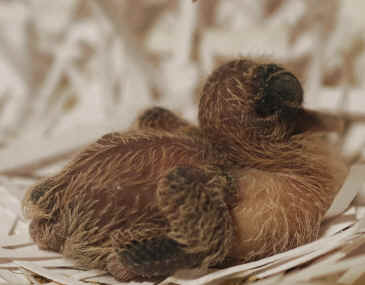
Why Birds Do Not Have Eggs
Why Fertilized Eggs Do Not Hatch
Why Eggs Are Not
Laid in the Nest
Why Eggs Are Not
Incubated Properly
Why Eggs Are Not Fertilized
When Males Are More Interested in Mating Than Feeding Their Babies
Why Babies Are Thrown Out of the Nest
Emergency Egg Incubation
Emergency Baby Care
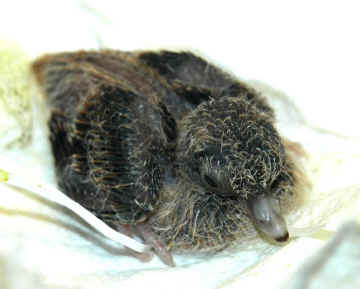
Emergency Baby Feeding
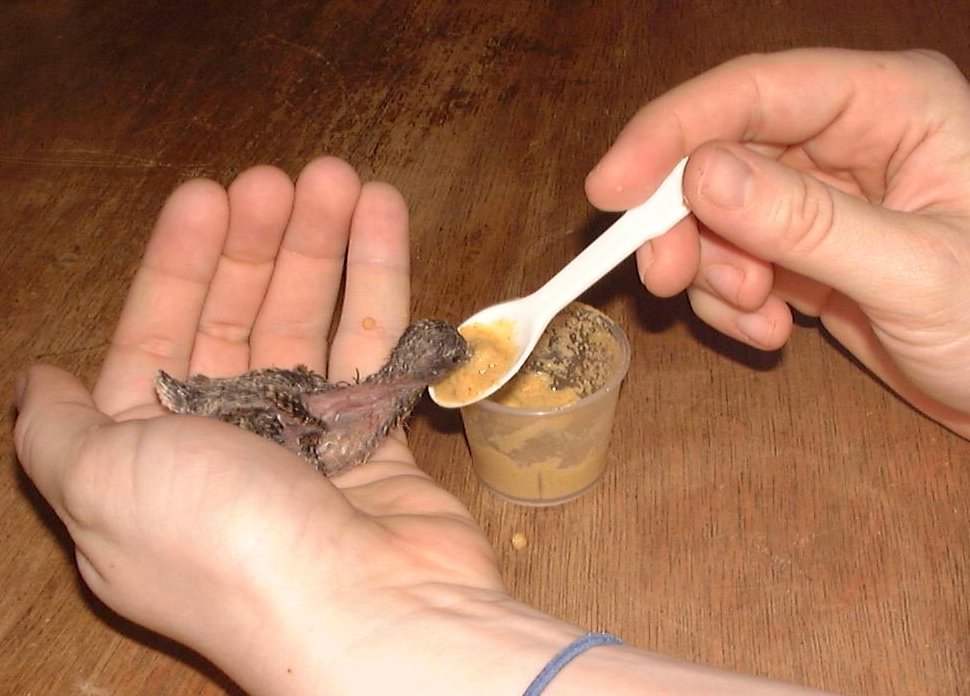
Fledgling Activity
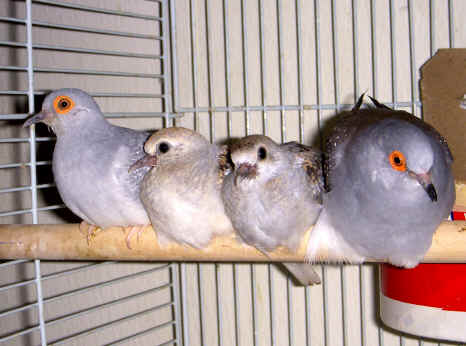
Removing Babies From the Parents' Cage
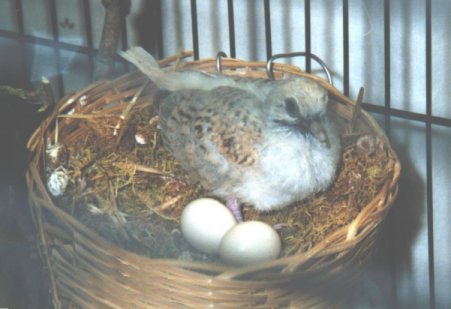
References
(1) Brown, Danny, "Reproductive Manipulation Techniques", A Guide to Pigeons, Doves & Quail, Their Management, Care & Breeding, South Tweeds Heads, Australia: Australian Birdkeeper 1995, pp. 32-39
(2) Gos, Michael W., "Breeding Doves", Doves. Neptune City, NJ: T.F.H. Publications, Inc., 1989, p.
56-63
(3) Naether, Carl A., "Diamond Doves" Chapter 7 of Raising Doves and Pigeons. New York: David McKay Company, Inc., 1979, pp. 94-99
(4) Vriends, Matthew M., PhD., "Breeeding Tropical Doves" Doves, A Complete Pet Owner's Manual. Happauge, NY: Barrons Educational Series, Inc., 1994 , pp. 34-39
Helen White
P. O. Box 367,
Tallahassee, FL 32302-0367